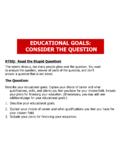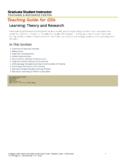Transcription of CHAPTER 1 The Nature of Curriculum
1 2 The intent of this introductory CHAPTER is to provide Curriculum leaders with a general overview of the Curriculum field and a set of concepts for analyzing the field. To accom-plish these related goals , the discussion that follows focuses on these outcomes: defining the concept of Curriculum , examining the several types of curricula, describing the con-trasting Nature of Curriculum components, and analyzing the hidden Curriculum . Some fundamental concepts essential for understanding the comprehensive field of Curriculum can be established at the outset. What is Curriculum , and why is it important? What are the types and components of curricula, and how have they changed over the years? What are the three Ds of Curriculum standards? What are mastery, organic, and enrichment curricula, and what roles do they play in the development of Curriculum ? Why is knowledge of the hidden Curriculum important to Curriculum leaders?
2 Questions addressed in this CHAPTER include the following:Key to LeadershipCurriculum leaders should review and monitor Curriculum policies to make sure the policies align with curricular goals and support student Nature of CurriculumCHAPTER 1 CHAPTER 1 The Nature of Curriculum3 THE CONCEPT OF CURRICULUMIn a sense, the task of defining the concept of Curriculum is perhaps the most difficult of all, for the term Curriculum has been used with quite different meanings ever since the field took form. Curriculum , however, can be defined as prescriptive, descriptive, or [ Curriculum ] definitions provide us with what ought to happen, and they more often than not take the form of a plan, an intended program, or some kind of expert opinion about what needs to take place in the course of study. (Ellis, 2004, p. 4)Analogous to prescriptive curricula are medical prescriptions that patients have filled by pharmacists; we do not know how many are actually followed.
3 The best guess is that most are not (p. 4). This is parallel to the prescribed Curriculum for schools where the teacher, like the patient, ultimately decides whether the prescription will be followed. In essence, the developer proposes, but the teacher disposes (p. 4).To understand the Nature and extent of Curriculum diversity, it is important at this junc-ture to examine the prescriptive and descriptive definitions offered by some of the past and present leaders in the field. The prescriptive definitions in Exhibit , arranged chrono-logically, have been chosen for their Prescriptive Definitions of CurriculumDateAuthorDefinition1902 John DeweyCurriculum is a continuous reconstruction, moving from the child s present experience out into that represented by the organized bodies of truth that we call studies .. the various studies .. are themselves experience they are that of the race.
4 (pp. 11 12)1918 Franklin BobbittCurriculum is the entire range of experiences, both directed and undirected, concerned in unfolding the abilities of the individual. (p. 43)1927 Harold O. Rugg[The Curriculum is] a succession of experiences and enterprises having a maximum lifelikeness for the learner .. giving the learner that development most helpful in meeting and controlling life situations. (p. 8)1935 Hollis Caswell in Caswell & CampbellThe Curriculum is composed of all the experiences children have under the guidance of teachers.. Thus, Curriculum considered as a field of study represents no strictly limited body of content, but rather a process or procedure. (pp. 66, 70)1957 Ralph Tyler[The Curriculum is] all the learning experiences planned and directed by the school to attain its educational goals . (p. 79)(Continued)PART I FOUNDATIONS OF CURRICULUM4 The descriptive definitions of Curriculum displayed in Exhibit go beyond the pre-scriptive terms as they force thought about the Curriculum not merely in terms of how things ought to be.
5 But how things are in real classrooms (Ellis, 2004, p. 5). Another term that could be used to define the descriptive Curriculum is experience. The experienced Curriculum provides glimpses of the Curriculum in action. Several examples, in chrono-logical order, of descriptive definitions of Curriculum are listed in Exhibit definitions provided for prescriptive and descriptive curricula vary primarily in their breadth and emphasis. It would seem that a useful definition of Curriculum should meet two criteria: It should reflect the general understanding of the term as used by educa-tors, and it should be useful to educators in making operational following definition of Curriculum is offered and will be used in this work: The Curriculum is the plans made for guiding learning in the schools, usually represented in retrievable documents of several levels of generality, and the actualization of those plans in the classroom, as experienced by the learners and as recorded by an observer; those experiences take place in a learning environment that also influences what is Tip your opinion, which definition is appropriate today?
6 Why?EXHIBIT (Continued)DateAuthorDefinition1967 Robert GagneCurriculum is a sequence of content units arranged in such a way that the learning of each unit may be accomplished as a single act, provided the capabilities described by specified prior units (in the sequence) have already been mastered by the learner. (p. 23)1970 James Popham & Eva Baker[ Curriculum is] all planned learning outcomes for which the school is responsible.. Curriculum refers to the desired consequences of instruction. (p. 48)1997J. L. McBrien & R. Brandt[ Curriculum ] refers to a written plan outlining what students will be taught (a course of study). Curriculum may refer to all the courses offered at a given school, or all the courses offered at a school in a particular area of Department of EducationCurriculum means the planned interaction of pupils with instructional content, materials, resources, and processes for evaluating the attainment of educational objectives.
7 ( )Several points in this definition need to be emphasized. First, it suggests that the term Curriculum includes both the plans made for learning and the actual learning experiences provided. Limiting the term to the plans made for learning is not enough, because, as will CHAPTER 1 The Nature of Curriculum5be discussed below, those plans are often ignored or modified. Second, the phrase retriev-able documents is sufficiently broad in its denotation to include curricula stored in a digital form , software and/or shared on the Internet. Also, those documents, as will be more fully explained below, are of several levels of specificity: Some, such as curricular policy statements, are very general in their formulation; others, such as daily lesson plans, are quite specific. Third, the definition notes two key dimensions of actualized curricu-lum: the Curriculum as experienced by the learner and that which might be observed by a disinterested observer.
8 Finally, the experienced Curriculum takes place in an environ-ment that influences and impinges on learning, constituting what is usually termed the hidden the definition, for the sake of brevity, does not deal explicitly with the relation-ship between Curriculum and instruction, an implicit relationship does exist. Instruction is viewed here as an aspect of Curriculum , and its function and importance change through-out the several types of curricula. First, in the written Curriculum , when the Curriculum is a set of documents that guide planning, instruction is only one relatively minor aspect of the Curriculum . Those retrievable documents used in planning for learning typically specify five components: a rationale for the Curriculum ; the aims, objectives, and content for achieving those objectives; instructional methods; learning materials and resources; and tests or assessment Descriptive Definitions of CurriculumDateAuthorDefinition1935 Hollis Caswell & Doak CampbellAll the experiences children have under the guidance of HopkinsThose learnings each child selects, accepts, and incorporates into himself to act with, on, and upon, in subsequent B.
9 RaganAll experiences of the child for which the school accepts HassThe set of actual experiences and perceptions of the experiences that each individual learner has of his or her program of Tanner & Laurel TannerThe reconstruction of knowledge and experience that enables the learner to grow in exercising intelligent control of subsequent knowledge and F. BrownAll student school experiences relating to the improvement of skills and strategies in thinking critically and creatively, solving problems, working collaboratively with others, communicating well, writing more effectively, reading more analytically, and conducting research to solve SilvaAn emphasis on what students can do with knowledge, rather than what units of knowledge they have, is the essence of 21st-century your opinion, which definition is appropriate today? Why?PART I FOUNDATIONS OF CURRICULUM6 Consequently, instruction is a component of the planned Curriculum and is usually seen as less important than the aims, objectives, and content at the actualized level; when the planned or written Curriculum is actually delivered, instruction takes on a new importance.
10 For that reason, administrators and supervisors should view the Curriculum as the total learning experience for students and focus on instruction how teachers are TYPES OF CURRICULAThe definition stipulated above suggests that there is a major difference between the planned Curriculum and actualized Curriculum . Yet even these distinctions are not suffi-ciently precise to encompass the several different types of curricula. It is important to note that the word Curriculum (as defined from its early Latin origins) means literally to run a course. If students think of a marathon with mile and direction markers, signposts, water stations, and officials and coaches along the route, they can better understand the concept of types of Curriculum (Wilson, 2005).As early as the late 1970s, Goodlad and associates (1979) were perhaps the first to sug-gest several key distinctions.


















